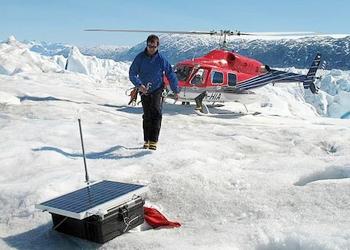
ARLINGTON, Virginia, October 25, 2016 (ENS) – A Scottish glaciologist with the U.S. Antarctic Program was fatally injured Saturday when the snowmobile he was riding fell into a deep crack in an ice sheet, called a crevasse.
Dr. Gordon Hamilton, 50, of the University of Maine Climate Change Institute, was working on White Island in Antarctica’s Ross Archipelago in an area where he has conducted research for several seasons, when his snowmobile plunged into the crevasse. He was killed in the 100-foot fall, according to the National Science Foundation.

Dr. Hamilton’s body has been recovered and will be returned to his family in Maine. An accident investigation conducted by U.S. Antarctic Program personnel has begun.
Hamilton’s team was camped in a heavily crevassed area known as the Shear Zone (SZ), some 25 miles south of McMurdo Station, the largest of the three U.S. research stations in Antarctica.
The McMurdo SZ is a three-mile wide and more than 125-mile long area of intensely crevassed ice where the Ross Ice Shelf meets the McMurdo Ice Shelf. The ice is up to 650 feet thick in this area.
The U.S. Antarctic Program is managed by the National Science Foundation, which coordinates all U.S. research and logistical support on the continent and aboard ships in the Southern Ocean.
“I am deeply saddened by the news of the tragic death of Dr. Hamilton. Our thoughts are with the family and entire community as we mourn this loss,” said Dr. France Córdova, director, National Science Foundation.
Dr. Hamilton’s research utilized two robots that contained ground-penetrating radar instruments to study the stability of the Ross and McMurdo ice shelves.
At the time of the accident, the science team was camped about 200 yards from the U.S. Antarctic Program’s South Pole Operations Traverse crevasse remediation team.
The two teams, science and Traverse operations, were working together to identify and remediate crevasses that had appeared in the past year.

The two teams included experienced personnel who had worked in this area over the past several years and all members of both teams had received crevasse and glacial safety training before going into the area.
In addition, mountaineers, familiar and experienced with the Shear Zone, were with each of the two teams. Crevasses had been identified and filled earlier in the week and work on a newly identified crevasse was beginning at the time of the accident.
Dr. Kelly Falkner, director, Division of Polar Programs, National Science Foundation, said, “The death of one of our colleagues is a tragic reminder of the risks we all face – no matter how hard we work at mitigating those risks – in field research. Gordon will be missed by many and our hearts go out to all whose lives he touched.”
Dr. Hamilton joined the university’s Climate Change Institute in 2000 as an assistant research professor and at the time of his death was an associate research professor.
Prior to coming to Maine, he was at the Byrd Polar Research Center at Ohio State University and the Norwegian Polar Institute in Olso after completing his doctorate from the University of Cambridge.
He studied the behavior of modern ice sheets and their role in the climate system. His research focused on understanding ice sheet mass balance – how much mass is coming in and going out, and the processes responsible – and involved satellite remote sensing.
His current research projects included ice-ocean interaction in Greenland and ice shelf stability in Antarctica.
He also taught undergraduate and graduate courses at the university, and was involved in statewide Science, Technology, Engineering and Mathematics (STEM) initiatives for grades 9-12.
“Gordon was the quintessential scientist and educator,” says Jeffrey Hecker, UMaine executive vice president for academic affairs and provost. “His research informed his teaching and his community outreach – from schoolchildren to lawmakers and the media.”
“He knew the importance of hands-on learning, and often took students into the field on his research expeditions. Students appreciated his depth of knowledge as a pioneering researcher, his dedication to being involved in student success and his style as an approachable, effective educator,” said Hecker. “He touched – and changed – many lives.”
In a statement released Sunday, Climate Change Institute Director Paul Mayewski said that the entire glaciology community held Hamilton in the absolute highest esteem.
“His experience and devotion to understanding glacier dynamics and their role in our evolving climate system, notably with respect to sea level rise, were Gordon’s scientific passions,” Mayewski said. “He led many polar expeditions in the course of his research, trained many graduate students, lectured far and wide, and was a well-known science spokesman in many media outlets.”
“Those of us who shared time in the field with Gordon know how important he was not only as a fellow team member and scientist, but also how wonderful and how much fun it was to be with him,” said Mayewski. “We send our deepest sympathy to his family and want them to know how much we appreciate the opportunity to have known him and how important his legacy is to our Institute and the scientific community.”
Dr. Hamilton worked with NASA’s ASTER Science Team from 2004 to the present. He served as associate editor of the “Journal of Geophysical Research – Earth Surface,” from 2007 to the present.
Dr. Hamilton said about his work, “I am interested in ice sheet mass balance and the role ice sheets play in modulating global sea levels. This research currently involves field work in Greenland and Antarctica, using GPS to study ice flow dynamics and GPR to understand snow accumulation, as well as satellite remote sensing of both ice sheets and other glacierized regions.”
He expressed interest “in the promoting the public understanding of climate change science.”
Copyright Environment News Service (ENS) 2016. All rights reserved.
© 2016, Environment News Service. All rights reserved. Content may be quoted only with proper attribution and a direct link to the original article. Full reproduction is prohibited.
